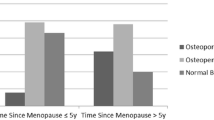Abstract:
The importance of malnutrition as a risk factor in osteoporosis is emphasized by the evidence that patients with fractures of the proximal femur are often undernourished. In this study, nutritional status, bone mineral mass and its association with body composition were investigated in underweight and normal weight elderly subjects. Moreover the hypothesis that malnutrition in elderly is associated with a higher risk of osteoporosis was tested. The participants were 111 elderly subjects divided into two groups according to body mass index (BMI): 51 patients were underweight (BMI < 22 kg/m2) while in 60 subjects BMI ranged from 22 to 30 kg/m2. In all patients anthropometric parameters and blood indices of malnutrition and of bone turnover were measured. Fat-free soft mass (FFSM), fat mass (FM), bone mineral content (BMC) and bone mineral density (BMD) ‘total body’ and at the hip were obtained by dual-energy X-ray densitometry. Dietary intake was evaluated with the diet history method, while resting energy expenditure (REE) was measured by indirect calorimetry. Underweight subjects had other signs of malnutrition, such as low visceral proteins, sarcopenia, and an inadequate energy intake. Moreover they showed a significant reduction of BMC and BMD compared with normal subjects. In men with BMI <22 kg/m2, T-score was below −2.5 (−3 at femoral neck and −2.7 at total hip) while men in the control group had normal bone mineral parameters. T-score at different sites was lower in underweight women than in underweight men, always showing values under −3.5, with clear osteoporosis and a high fracture risk. In healthy women the T-score values indicated the presence of mild osteoporosis. In underweight subjects, low levels of albumin (< 35 g/l) were associated with higher femoral bone loss. Using a partial correlation model, BMC, adjusted for age, bone area, knee height and albumin showed a significant association with FM in women (r= 0.48; p < 0.01) and with FFSM in men (r= 0.48; p < 0.05). Albumin, when adjusted for other variables, was significantly correlated (r= 0.52; p < 0.05) with femoral neck BMC only in women. In conclusion, the underweight state in the elderly is associated with malnutrition and osteoporosis; other factors occurring in malnutrition, besides body composition changes, such as protein deficiency, could be involved in the association between underweight and osteoporosis. Moreover bone mineral status seems to be related to fat-free soft mass tissue in men while in women it is much more closely associated with total body fat.
Similar content being viewed by others
Author information
Authors and Affiliations
Additional information
Received: 3 January 2000 / Accepted: 3 July 2000
Rights and permissions
About this article
Cite this article
Coin, A., Sergi, G., Benincà, P. et al. Bone Mineral Density and Body Composition in Underweight and Normal Elderly Subjects . Osteoporos Int 11, 1043–1050 (2000). https://doi.org/10.1007/s001980070026
Issue Date:
DOI: https://doi.org/10.1007/s001980070026




